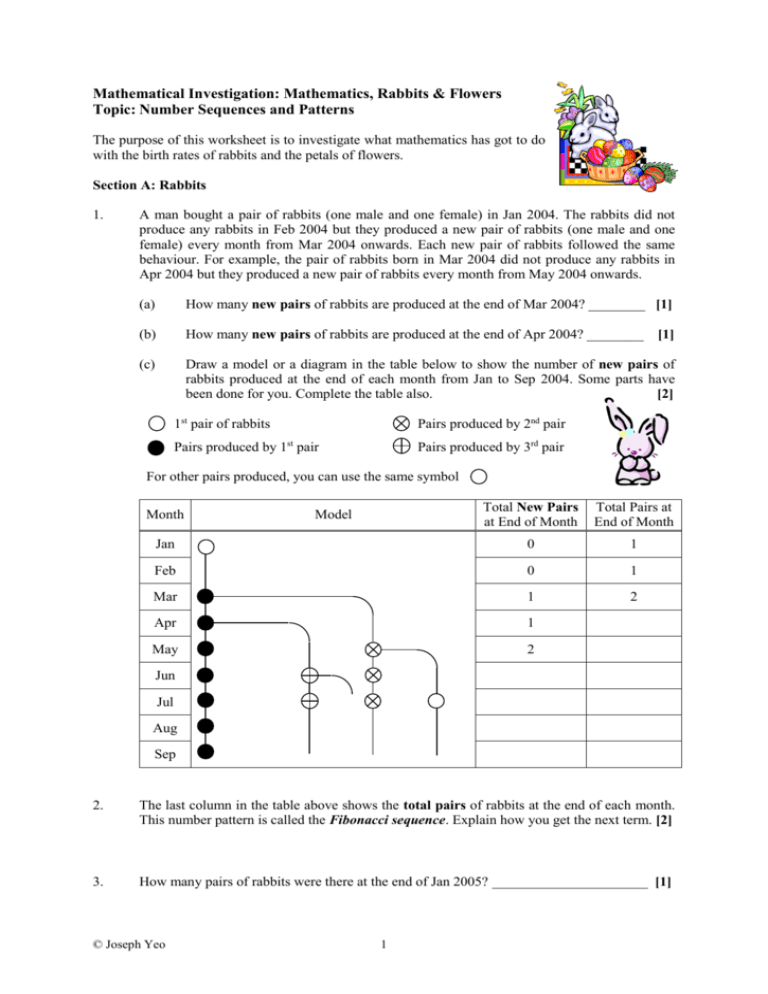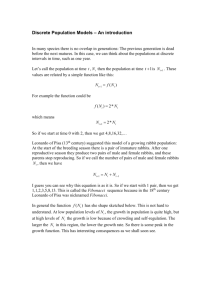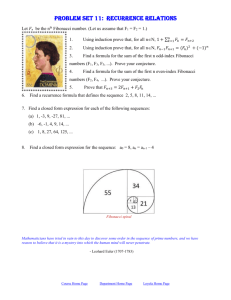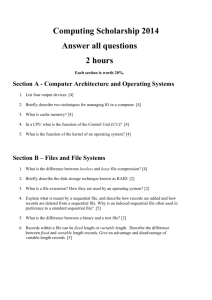Mathematical Investigation: Paper Size
advertisement

Mathematical Investigation: Mathematics, Rabbits & Flowers
Topic: Number Sequences and Patterns
The purpose of this worksheet is to investigate what mathematics has got to do
with the birth rates of rabbits and the petals of flowers.
Section A: Rabbits
1.
A man bought a pair of rabbits (one male and one female) in Jan 2004. The rabbits did not
produce any rabbits in Feb 2004 but they produced a new pair of rabbits (one male and one
female) every month from Mar 2004 onwards. Each new pair of rabbits followed the same
behaviour. For example, the pair of rabbits born in Mar 2004 did not produce any rabbits in
Apr 2004 but they produced a new pair of rabbits every month from May 2004 onwards.
(a)
How many new pairs of rabbits are produced at the end of Mar 2004? ________ [1]
(b)
How many new pairs of rabbits are produced at the end of Apr 2004? ________ [1]
(c)
Draw a model or a diagram in the table below to show the number of new pairs of
rabbits produced at the end of each month from Jan to Sep 2004. Some parts have
been done for you. Complete the table also.
[2]
1st pair of rabbits
Pairs produced by 2nd pair
Pairs produced by 1st pair
Pairs produced by 3rd pair
For other pairs produced, you can use the same symbol
Total New Pairs
at End of Month
Total Pairs at
End of Month
Jan
0
1
Feb
0
1
Mar
1
2
Apr
1
May
2
Month
Model
Jun
Jul
Aug
Sep
2.
The last column in the table above shows the total pairs of rabbits at the end of each month.
This number pattern is called the Fibonacci sequence. Explain how you get the next term. [2]
3.
How many pairs of rabbits were there at the end of Jan 2005? ______________________ [1]
© Joseph Yeo
1
Section B: Flowers
4.
5.
1
Write down the number of petals1 for each flower below.
[1]
Picture A: White Calla Lily
Picture B: Euphorbia
Picture C: Waterplantain
Picture D: White Vinca
Picture E: Moonbeam Coreopsis
Picture F: Orange Zinnia
What do you notice about these numbers?
[1]
For botanists, some of these so-called ‘petals’ are actually sepals or bracts. But laymen like you and me would
not be able to differentiate between them. So the term ‘petals’ here refers to what we laymen normally would
call ‘petals’.
© Joseph Yeo
2
6.
7.
However there are exceptions. Write down the number of petals for each flower below.
Picture G: Ixora
Picture H: Daylily
Picture I: Starflower
Picture J: Passion Flower
[1]
One type of exception is that the number of petals follows the Lucas Sequence. The Lucas
Sequence is just like the Fibonacci Sequence except that the starting two numbers are 2 and 1,
instead of 1 and 1. Write down the next 5 terms in the Lucas Sequence below:
2, 1, 3, ______ , ______ , ______ , ______ , ______ , …
[1]
8.
Write down the first 3 numbers in the Lucas Sequence that are not Fibonacci numbers.
[1]
9.
Compare your answers in Q6 and Q8. Which flowers are still exceptions, i.e. their number of
petals is not a Fibonacci or a Lucas number? Write down their number of petals also.
[2]
10.
The second type of exception is the doubling of petals from a Fibonacci number. Which
Fibonacci numbers give rise to the exceptions in Q9?
[1]
11.
The third type of exception is due to mutants or hybrids created artificially. Nowadays roses
come with many different petals because they have been created artificially. Make a guess
how many petals a wild rose (i.e. not a hybrid) has. Or you can search the Internet for more
information. Hint: It is a Fibonacci number.
[1]
© Joseph Yeo
3
12.
Hence write down the numbers of petals a natural flower (excluding mutants) can have. Just
list the first 10 numbers.
[1]
Further Investigation
13.
One of the most important questions in any mathematical investigation that you should ask
yourself is: “What else is there for me to investigate?” List one thing related to this topic that
you would like to investigate further and investigate it.
[2]
Question: __________________________________________________________________
Answer:
Conclusion
14.
Write down one main lesson that you have learnt from this worksheet.
Final Score:
/ 20
Final Score
16-20
13-15
10-12
7-9
0-6
Grade
A
B
C
D
F
Teacher’s Comments (if any):
© Joseph Yeo
[1]
4
Mathematical Investigation: Mathematics, Rabbits & Flowers
Topic: Number Sequences and Patterns
Answers & Scoring Rubric
(Marks allocated in square brackets; total marks = 20)
Section A: Rabbits
1.
(a)
(b)
(c)
1 new pair
[1]
1 new pair
[1]
Refer to OHT template on 7.
[2] {1 m for diagram, 1 m for last 2 columns}
2.
To get next term, add the two preceding terms. [2]
[Important generalisation: so more marks; no 1 mark: either 2 or 0]
3.
233 pairs of rabbits at end of Jan 2005.
[1]
[For your info, the first 25 terms of the Fibonacci sequence are: 1, 1, 2, 3, 5, 8, 13, 21, 34, 55,
89, 144, 233, 377, 610, 987, 1597, 2584, 4181, 6765, 10946, 17711, 28657, 46368, 75025]
Section B: Flowers
4.
Each flower in Pictures A to F has 1, 2, 3, 5, 8 and 13 petals respectively.
[1]
5.
Number of petals in a flower is a Fibonacci number.
[1]
6.
Each flower in Pictures G to I has 4, 6 and 7 petals respectively.
[1]
7.
Lucas Sequence: 4, 7, 11, 18, 39
[1]
8.
4, 7, 11
[1]
9.
Daylily: 6 petals; Passion Flower: 10 petals
[2]
10.
3, 5
[1]
11.
Wild Rose: 5 petals
[1]
[This is not strictly guesswork because students can search the Internet, as suggested in the
question. Just type ‘wild rose’ in any search engine.]
12.
1, 2, 3, 4, 5, 6, 7, 8, 10, 11
[1]
Further Investigation
13.
Some suggestions for further investigations: [2] {Full marks for creative or original idea}
What other patterns in nature have something to do with the Fibonacci sequence?
Ans: For more info, see http://ccins.camosun.bc.ca/~jbritton/fibslide/jbfibslide.htm and
http://library.thinkquest.org/27890/applications5.html. If these sites are not
available, go to http://math.nie.edu.sg/bwjyeo/aa for new updates.
What other examples can you think of that will also generate a Fibonacci sequence? E.g.
you have a massive stack of 10¢ and 20¢ coins and you are feeding them into your piggy
© Joseph Yeo
5
bank. How many ways can you put 10¢, 20¢, 30¢, 40¢, … into your piggy bank? The
order of feeding the coins into your piggy bank is important.
Ans: The number of ways forms a Fibonacci sequence.
Is there any pattern for the differences between consecutive terms in a Fibonacci
sequence?
Ans: It is another Fibonacci sequence (see Q1c Table)
How do you generate Fibonacci numbers using Excel?
Ans: The gist of it is: B4=1, B5=1, B6=B4+B5, and then auto-complete for B7 onwards.
For more info, download Fibonacci.xls from http://math.nie.edu.sg/bwjyeo/aa.
Since the next term in a Fibonacci sequence is obtained from the sum of the two
preceding terms, does that mean we have to start with the first two terms or why must the
second term be ‘1’?
Ans: Since there is nothing in the zero-th term (T0), then T0 = 0 and so T2 = T0 + T1 = 0 +
1 = 1. So we just need the first term. But there are also other sequences that are
similar to the Fibonacci sequence where we define the first two terms and the next
term is the sum of the two preceding terms, e.g. Lucas sequence (see Q7 above).
1 8.9 = 0.11235 95505 61797 75280 89887 64044… is an interesting number. The first
few digits after the decimal point are Fibonacci numbers. But why are the rest different?
How do you arrange the Fibonacci numbers to get the rest?
Ans: Arrange the Fibonacci numbers with the units of each number in a diagonal and
then add them up from the right (there is carry over). Refer to diagram below and
OHT template on 8. The last few digits are not accurate because the sequence stops
at 610. But why does it work?
1
1
2
3
5
8
1
1
1
2
3
5
3
2
9
5
1
3
5
4
5
0
5
8
1
5
9
4
2
6
Conclusion
14.
Some suggestions for main lesson learnt from this worksheet:
Fibonacci numbers occur in nature.
Mathematics occurs in nature.
© Joseph Yeo
6
[1]
4
3
3
1
3
7
6
6
7
1
8
0
0
1st pair of rabbits
Pairs produced by 1st pair
Month
Pairs produced by 2nd pair
Pairs produced by 3rd pair
Total New Pairs Total Pairs at
at End of Month End of Month
0
1
0
1
1
2
1
3
2
5
3
8
5
13
8
21
13
34
Model
Jan
Feb
Mar
Apr
May
Jun
Jul
Aug
Sep
© Joseph Yeo
7
1
1
2
3
5
8
1
1
© Joseph Yeo
1
2
3
5
9
3
2
5
1
3
5
8
4
5
0
5
8
1
5
9
4
2
6
4
3
3
1
3
7
6
6
7
1
8
0
0








